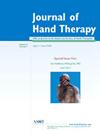手动淋巴引流能成为轻中度腕管综合征的一种新的治疗选择吗?一项随机对照研究。
IF 1.8
4区 医学
Q2 ORTHOPEDICS
引用次数: 0
摘要
背景:腕管综合征是上肢最常见的压迫性神经病变,因此评估各种物理治疗的有效性是必要的。目的:本研究旨在确定手工淋巴引流(MLD)与单纯矫形器对轻度至中度腕管综合征患者的临床和电诊断的改善。研究设计:这是一项前瞻性随机对照研究。方法:本组共36例符合纳入标准的患者。实验组采用MLD +矫形器,对照组仅采用矫形器。治疗前后采用电诊断测试、视觉模拟量表、疼痛测量(压痛阈值)、波士顿腕管综合征问卷对患者进行评估。治疗前后(4周后)进行评价。结果:两种治疗方法均显著改善了实验组和对照组的波士顿腕管综合征问卷评分(p < 0.001, d = 2.0)和对照组(p < 0.001, d = 1.5)。实验组腕横韧带水平的压痛阈值显著升高(p = 0.02, d = 0.86, 95%可信区间(CI) = -0.08 ~ 1.2)。在尺桡关节远端和趾共伸肌水平,两组治疗后的压痛阈值相似地增加(p = 0.65, d = 0.31, 95% CI = -0.44 ~ 1.2),但实验组治疗后的压痛阈值增加显著(p = 0.007, d = 0.31)。实验组的运动速度(p = 0.001, d = 0.98)、幅度(p = 0.002, d = 1.5)、潜伏期(p = 0.002, d = 0.60)和感觉速度(p = 0.03, d = 0.91)、潜伏期(p = 0.001, d = 1.2)均有显著改善,而对照组仅运动速度和幅度(p = 0.047, d = 0.59)有显著变化。实验组治疗后感觉改善明显高于对照组(p = 0.01, d = 0.81, 95% CI = -0.78 ~ -0.49)。结论:MLD显著改善正中神经的感觉传导速度、幅度和潜伏期。此外,MLD和矫形器增加了疼痛压力阈值并导致功能改善。临床试验注册:研究编号:NCT05394870。本文章由计算机程序翻译,如有差异,请以英文原文为准。
Can manual lymphatic drainage be a new treatment option in mild-moderate carpal tunnel syndrome? A randomized controlled study
Background
Carpal tunnel syndrome is the most common entrapment neuropathy in the upper extremity, making it essential to assess the effectiveness of various physiotherapy treatments.
Purpose
This study aimed to determine the clinical and electrodiagnostic improvement in mild-to-moderate carpal tunnel syndrome patients through manual lymphatic drainage (MLD) versus an orthosis alone.
Study Design
This is a prospective randomized controlled study.
Methods
The sample consisted of a total of 36 patients who met the inclusion criteria. Experimental group received MLD and orthosis, and the control group received only orthosis. The patients were evaluated with electrodiagnostic tests, Visual Analog Scale, algometer measurements (pressure pain threshold), Boston Carpal Tunnel Syndrome Questionnaire before and after treatment. Evaluations were made before and after treatment (4 weeks later).
Results
Boston Carpal Tunnel Syndrome Questionnaire scores improved significantly with both treatment methods in both the experimental (p < 0.001, d = 2.0) and control groups (p < 0.001, d = 1.5). The pressure pain threshold significantly increased in the experimental group at the level of the transverse carpal ligament (p = 0.02, d = 0.86, 95% Confidence Interval (CI) = −0.08 to 1.2). At the distal radioulnar joint and extensor digitorum communis muscle levels, the pressure pain threshold similarly increased for two groups after treatment (p = 0.65, d = 0.31, 95% CI = −0.44 to 1.2), but the post-treatment increase in the experimental group was significant (p = 0.007, d = 0.31). In the experimental group, motor velocity (p = 0.001, d = 0.98), amplitude (p = 0.002, d = 1.5), and latency (p = 0.002, d = 0.60) and sensory velocity (p = 0.03, d = 0.91) and latency (p = 0.001, d = 1.2) significantly improved, while in the control group, there was a significant change only in motor velocity and amplitude (p = 0.047, d = 0.59). The post-treatment sensory improvement was significantly higher in the experimental group (p = 0.01, d = 0.81, 95% CI = −0.78 to −0.49).
Conclusions
MLD significantly improved sensory conduction velocity, amplitude, and latency of the median nerve. Additionally, MLD and orthosis increased the pain pressure threshold and led to functional improvement.
Clinical trial registration
This is listed with study ID: NCT05394870
求助全文
通过发布文献求助,成功后即可免费获取论文全文。
去求助
来源期刊

Journal of Hand Therapy
医学-外科
CiteScore
3.50
自引率
10.00%
发文量
65
审稿时长
19.2 weeks
期刊介绍:
The Journal of Hand Therapy is designed for hand therapists, occupational and physical therapists, and other hand specialists involved in the rehabilitation of disabling hand problems. The Journal functions as a source of education and information by publishing scientific and clinical articles. Regular features include original reports, clinical reviews, case studies, editorials, and book reviews.
 求助内容:
求助内容: 应助结果提醒方式:
应助结果提醒方式:


